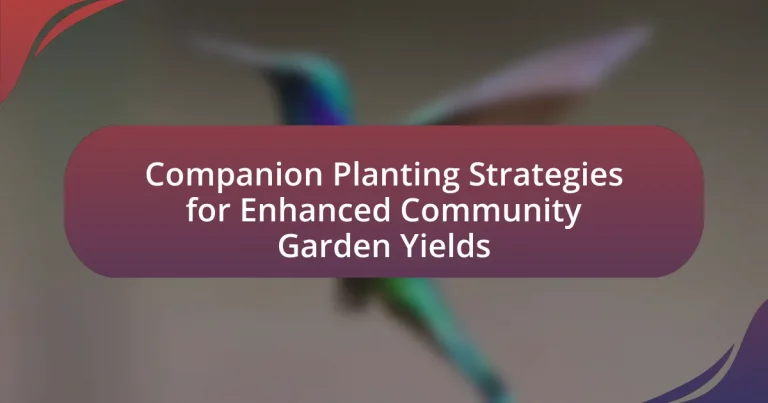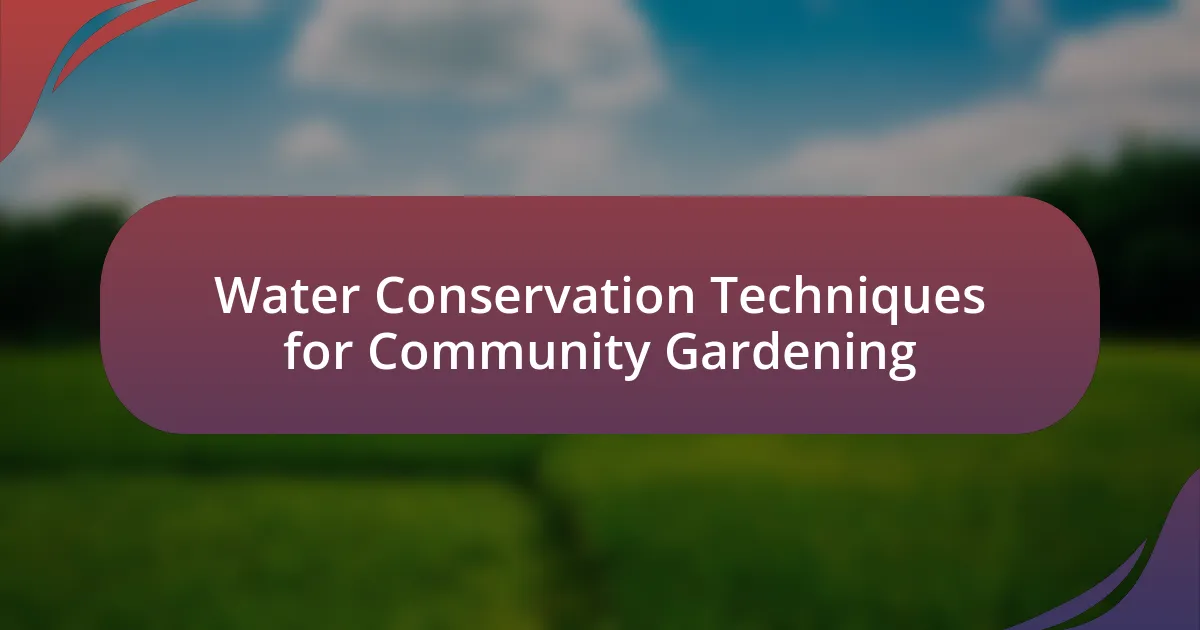Companion planting strategies involve the practice of growing different plants in proximity to achieve mutual benefits such as pest control, improved growth, and enhanced biodiversity, ultimately leading to increased yields in community gardens. Key principles include mutualism, pest deterrence, and nutrient enhancement, with successful pairings like tomatoes and basil demonstrating significant advantages. The article explores how these strategies can optimize plant relationships, improve soil health, and address challenges such as plant compatibility and pest attraction, while also highlighting best practices for community gardeners to maximize productivity and collaboration. Additionally, it provides resources for further learning about effective companion planting techniques.

What are Companion Planting Strategies?
Companion planting strategies involve the practice of growing different plants in proximity for mutual benefits, such as pest control, pollination, and improved growth. This method enhances biodiversity and can lead to increased yields in community gardens. For example, planting marigolds alongside vegetables can deter pests, while beans can fix nitrogen in the soil, benefiting neighboring plants. Research has shown that these strategies can improve overall garden health and productivity, making them a valuable approach for community gardening initiatives.
How do Companion Planting Strategies enhance garden yields?
Companion planting strategies enhance garden yields by optimizing plant relationships that promote growth and deter pests. For instance, planting tomatoes alongside basil can improve tomato flavor and growth due to basil’s ability to repel harmful insects. Research indicates that companion planting can increase yields by up to 20% by maximizing space and resources, as seen in studies conducted by the University of California, which found that intercropping can lead to more efficient nutrient use and reduced competition among plants.
What principles underlie Companion Planting Strategies?
Companion planting strategies are based on principles that promote beneficial interactions between different plant species. These principles include mutualism, where plants enhance each other’s growth, pest deterrence, where certain plants repel harmful insects, and nutrient enhancement, where one plant improves soil fertility for another. For example, the combination of tomatoes and basil is known to improve flavor and deter pests, demonstrating the effectiveness of these principles in practice.
How do different plants interact in Companion Planting?
Different plants in companion planting interact through beneficial relationships that enhance growth, deter pests, and improve soil health. For example, planting marigolds alongside vegetables can repel nematodes and other harmful insects, while legumes like beans fix nitrogen in the soil, benefiting neighboring plants. Research indicates that these interactions can lead to increased yields; a study published in the Journal of Sustainable Agriculture found that intercropping can boost productivity by up to 20% compared to monoculture systems. Thus, the strategic pairing of plants in companion planting creates a synergistic environment that promotes overall garden health and productivity.
Why is Companion Planting important for community gardens?
Companion planting is important for community gardens because it enhances biodiversity, improves pest control, and increases crop yields. By strategically planting compatible species together, gardeners can create a more resilient ecosystem that naturally deters pests and diseases. For instance, the presence of marigolds can repel nematodes and other harmful insects, while planting beans alongside corn can provide nitrogen fixation, benefiting both plants. Research indicates that these practices can lead to a 20-30% increase in yields compared to monoculture planting, demonstrating the effectiveness of companion planting in maximizing the productivity of community gardens.
What benefits does Companion Planting provide to community gardeners?
Companion planting provides community gardeners with enhanced pest control, improved plant growth, and increased biodiversity. By strategically pairing plants, gardeners can deter pests naturally; for example, marigolds repel nematodes and aphids, benefiting neighboring crops. Additionally, certain plant combinations can enhance nutrient uptake and growth rates, as seen with the classic pairing of tomatoes and basil, which thrive together. This method also fosters a diverse ecosystem, attracting beneficial insects and pollinators, which further supports garden health and productivity.
How does Companion Planting contribute to biodiversity?
Companion planting contributes to biodiversity by promoting a diverse range of plant species in close proximity, which enhances ecosystem resilience and stability. This practice encourages beneficial interactions among plants, such as pest control, pollination, and nutrient sharing, leading to a more balanced and productive garden environment. Research indicates that diverse plant communities can support a wider array of beneficial insects and microorganisms, which are crucial for maintaining soil health and plant vitality. For example, studies have shown that intercropping can increase the abundance of pollinators and natural pest predators, thereby fostering a more biodiverse ecosystem.

What are the key techniques in Companion Planting?
The key techniques in companion planting include intercropping, trap cropping, and using beneficial plant relationships. Intercropping involves planting different crops in proximity to enhance growth and yield; for example, planting corn with beans allows the beans to climb the corn while fixing nitrogen in the soil. Trap cropping uses specific plants to attract pests away from the main crops, effectively protecting them; for instance, planting radishes can lure away pests from nearby cabbage. Additionally, beneficial plant relationships, such as planting marigolds with tomatoes, can deter nematodes and other pests, promoting healthier plants. These techniques are supported by studies indicating that companion planting can increase crop yields by up to 20% and reduce pest damage significantly.
How can gardeners effectively implement Companion Planting?
Gardeners can effectively implement companion planting by strategically pairing plants that benefit each other, such as planting marigolds with tomatoes to deter pests. This method enhances growth, improves yields, and reduces the need for chemical pesticides. Research indicates that certain combinations can increase crop productivity; for instance, a study published in the Journal of Agricultural Science found that intercropping legumes with cereals can boost overall yield by up to 20%. By understanding the specific benefits of plant pairings, gardeners can create a more resilient and productive garden ecosystem.
What are the best plant pairings for successful Companion Planting?
The best plant pairings for successful companion planting include tomatoes with basil, carrots with onions, and beans with corn. Tomatoes and basil enhance each other’s growth and flavor, while carrots and onions help deter pests that affect each other. Beans fix nitrogen in the soil, benefiting corn, which requires nitrogen for robust growth. These pairings are supported by studies showing increased yields and reduced pest issues when these plants are grown together.
How can gardeners identify compatible and incompatible plants?
Gardeners can identify compatible and incompatible plants by researching plant families and their growth habits, as well as understanding their nutrient needs and pest resistance. For example, legumes like beans enrich the soil with nitrogen, making them compatible with heavy feeders such as corn. Conversely, plants like onions and garlic can inhibit the growth of beans due to their allelopathic properties. Studies have shown that certain combinations can enhance yields by promoting beneficial interactions, while others can lead to reduced growth or increased pest problems.
What role does soil health play in Companion Planting?
Soil health is crucial in companion planting as it directly influences plant growth, nutrient availability, and pest resistance. Healthy soil promotes beneficial microbial activity, which enhances nutrient cycling and supports plant health, leading to improved yields. Research indicates that diverse root systems from companion plants can improve soil structure and fertility, further benefiting the overall ecosystem. For instance, studies show that legumes, when planted alongside other crops, can fix nitrogen in the soil, enriching it and supporting the growth of neighboring plants. Thus, maintaining soil health is essential for maximizing the benefits of companion planting in community gardens.
How can soil amendments support Companion Planting strategies?
Soil amendments can enhance Companion Planting strategies by improving soil fertility, structure, and microbial activity, which in turn supports plant health and growth. For instance, adding organic matter such as compost increases nutrient availability and water retention, benefiting companion plants that may have varying nutrient needs. Research indicates that well-amended soils can lead to increased yields; a study published in the Journal of Soil Science found that organic amendments can boost crop productivity by up to 30%. This improvement in soil quality fosters a more synergistic relationship between companion plants, allowing them to thrive together and maximize garden yields.
What soil conditions are ideal for Companion Planting?
Ideal soil conditions for companion planting include well-drained, nutrient-rich soil with a pH level between 6.0 and 7.0. Well-drained soil prevents waterlogging, which can harm plant roots, while nutrient-rich soil supports the diverse needs of companion plants. A balanced pH level ensures optimal nutrient availability, promoting healthy growth and maximizing yields. Research indicates that specific nutrient combinations, such as nitrogen, phosphorus, and potassium, enhance the benefits of companion planting by fostering plant health and resilience.

What challenges might arise with Companion Planting?
Companion planting can present several challenges, including plant compatibility issues, pest attraction, and nutrient competition. Certain plants may not thrive when grown together due to allelopathy, where one plant releases chemicals that inhibit the growth of another. Additionally, some companion plants can inadvertently attract pests that harm neighboring crops, undermining the intended benefits of the strategy. Furthermore, plants with similar nutrient requirements may compete for resources, leading to suboptimal growth for all involved. These challenges highlight the need for careful planning and research when implementing companion planting strategies in community gardens.
How can gardeners troubleshoot common issues in Companion Planting?
Gardeners can troubleshoot common issues in companion planting by observing plant interactions, adjusting planting combinations, and monitoring environmental conditions. For instance, if certain plants are not thriving together, gardeners should research compatibility and consider replacing one with a more suitable companion. Additionally, they should check for pests or diseases that may affect specific plant pairings, as some companions can attract harmful insects. Regularly assessing soil health and nutrient levels can also help address growth issues, as nutrient deficiencies can impact plant performance. Studies have shown that proper companion planting can enhance yields by up to 20%, indicating the importance of addressing these common issues effectively.
What pests and diseases can affect Companion Planting success?
Companion planting success can be affected by pests such as aphids, spider mites, and whiteflies, as well as diseases like powdery mildew and root rot. Aphids can damage plants by sucking sap, leading to stunted growth, while spider mites create webbing and cause leaf discoloration. Whiteflies can transmit viruses that further compromise plant health. Powdery mildew thrives in humid conditions and can spread rapidly, affecting foliage, while root rot, often caused by overwatering or poor drainage, can lead to plant death. These pests and diseases can disrupt the intended benefits of companion planting, such as pest control and improved growth, thereby reducing overall garden yields.
How can gardeners adapt their strategies to changing conditions?
Gardeners can adapt their strategies to changing conditions by implementing flexible planting schedules, selecting resilient plant varieties, and utilizing companion planting techniques. Flexible planting schedules allow gardeners to adjust sowing and harvesting times based on weather patterns, ensuring optimal growth. Resilient plant varieties, such as drought-tolerant or disease-resistant species, can withstand environmental stresses, thereby maintaining yields. Companion planting, which involves growing compatible plants together, enhances nutrient uptake and pest resistance, further supporting garden productivity under varying conditions. Research indicates that companion planting can increase yields by up to 20% by improving plant health and biodiversity.
What are some best practices for maximizing yields in community gardens?
To maximize yields in community gardens, implementing companion planting is essential. Companion planting involves strategically placing different plants together to enhance growth, deter pests, and improve pollination. For instance, planting tomatoes alongside basil can increase tomato yields by repelling pests and enhancing flavor. Research indicates that certain plant combinations can lead to a 20-30% increase in overall yield due to improved nutrient uptake and reduced competition. Additionally, utilizing crop rotation and intercropping can further optimize space and resources, leading to healthier plants and higher productivity.
How can community gardeners collaborate to enhance Companion Planting efforts?
Community gardeners can collaborate to enhance Companion Planting efforts by sharing knowledge about plant pairings that improve growth and pest resistance. For instance, gardeners can organize workshops to educate each other on effective combinations, such as planting marigolds with tomatoes to deter nematodes. Additionally, they can create a shared planting calendar to synchronize planting times, ensuring that compatible plants are grown together for optimal benefits. Research indicates that such collaborative approaches can lead to increased yields and healthier plants, as demonstrated in community gardens that have successfully implemented these strategies.
What resources are available for learning more about Companion Planting?
Books, online courses, and gardening websites are valuable resources for learning about Companion Planting. Notable books include “Carrots Love Tomatoes” by Louise Riotte, which details beneficial plant pairings, and “The Vegetable Gardener’s Bible” by Edward C. Smith, which covers various gardening techniques including companion planting. Online platforms like the University of California’s Agriculture and Natural Resources website provide research-based information on plant interactions. Additionally, websites such as the Old Farmer’s Almanac and gardening forums offer practical advice and community experiences related to companion planting. These resources collectively provide a comprehensive understanding of how to effectively implement companion planting strategies in community gardens.





